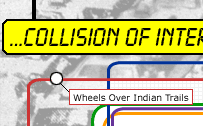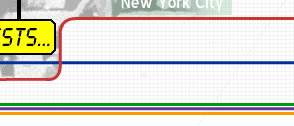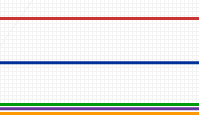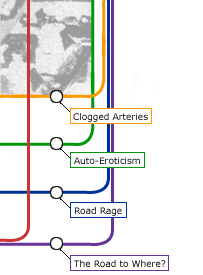



Situationist Theses on Traffic || The Social Ideology of the Motorcar || Killed by Automobile || Excess
How Traffic Destroys the Eco-City
by David Engwicht
The pedestrian remains the largest single obstacle to free traffic movement.
Los Angeles planning report.
You can draw any kind of pictures you like on a clean slate and indulge your every whim in the wilderness in laying out a New Delhi, Canberra or Brasilia, but when you operate in an overbuilt metropolis you have to back your way with a meat axe.
Robert Moses, City Construction Coordinator for New York, 1964
Spreading cities in every country march across the globe devouring half a million acres of land every day.
Peter Newman, Associate Professor
Murdoch University, Western Australia
Hey, this is toad turf
In 1935 the cane toad was imported into northern Queensland from Hawaii to combat a pest, the grey- backed beetle, which was affecting sugar cane crops. The cane toad had little effect on the beetle and within a short time had itself become a pest, spreading through the entire State and, eventually, into New South Wales. Recently my children, along with thousands of other Brisbane children, were asked by a council and State government to become 'toad busters'. Schools were encouraged to join in toad busting nights at Brisbane Forest Park. The toad had become a pest because in had upset the balance in the existing eco- system. Native frogs and other wildlife were disappearing because the delicate web of interrelationships that existed before the arrival of the toad was suddenly disrupted.
In a similar way the sudden injection of the car into the delicate web of relationships that constitute the Eco-City upsets a balance which had evolved thousands of years. Because planners and engineers have viewed the city as a machine for the production of goods and the street a machine for the movement of traffic, they have assumed that actions such as widening a road, allowing a regional shopping center, or allowing unrestrained car use in the city would have linear, predictable results. But of course they do not. The city is a complex, dynamic eco- system where disruption of the balance in one set of relationships, affects the balance in all the others. Like the frog in Brisbane, some things may even begin to disappear. What are the effects of introducing cars into the urban eco- system?
Competition for space
Space in a city can be divided into two broad categories: exchange space (homes, shops, work places, parks, community halls, etc.) and movement space (roads, car parks, train tracks, walkways, etc.) used as a means of getting to exchange space. Increasing the amount of movement space requires transforming space from exchange space to movement space. So to build a new road in an urban area, widen an existing road or build a car park, usually requires tearing down houses, work-places, community halls, or ripping up park or bushland. This conversion of space can also happen in an unseen way when the method of travel changes. Some space, for example the main street of Nuremburg, has a dual role; both movement and exchange. This was also true for the streets of Groningen where the streets were being used for both movement and social interaction. But if 30,000 cars were allowed to charge through the Nuremburg street or the streets of Groningen, this dual role d become a single role, converting the exchange dimension into a movement function.
What happens then when exchange space is overtly or covertly converted to movement space? Well some of it is replaced on the city fringe. Valuable farmland or irreplaceable nature assets on the fringe of the city are converted into residential areas, shopping centers or work places. But much of the exchange opportunity can never be replaced. The spontaneous exchange is gone forever, as have the historic buildings, parks or even good friends.
This has a twofold result. Firstly, the city, and therefore the people, are poor because they have some exchange opportunities obliterated. Secondly, they must travel further to reach the remaining exchange opportunities which are now spread over a greater area. This requires more movement which demands that more space be converted from exchange space to movement space, and so on. Even the motor vehicle industry understands this self-perpetuating cycle where new roads generate their own traffic which demands even more road space. In 1967 the Asphalt Institute Quarterly, the publication for oil and highway interest groups, stated:
Every new mile tacked on to paved road and street system is accompanied by the consumption of about 50,000 additional gallons of motor fuel a year. That's a total of 2.25 billion additional gallons of fuel use, accounted for by the added 45,000 miles of new roads built each year... In short, we have a self perpetuating cycle, the key element of which is year accommodate automotive travel, generate fuel consumption, produce road building revenue. Scratch the new roads and the cycle ceases to function.
This 'spreading-city syndrome' is compounded even further by the space demands of the car. Cars can take up to thirty times more space to move each person than public transport. Ironically, the faster traffic moves, the greater space it demands. Not only does faster traffic require a greater buffer front and back, it also requires a greater buffer on either side.
The car also requires greater amounts of space for storage. A car consumes 20 times the space needed to park a bike. Legs stay with their owner and require even less storage space. Because cars must have numerous car spaces that lie idle for long periods of time (at home, workplace, shopping center, pre-school, church, recreational facilities, etc.), the family car consumes about three times the more space than the average family home.
It may be argued that countries like the United States, Canada and Australia have unlimited space so the spreading-city syndrome is not such a problem. The question is not whether the space is limited or unlimited; it is, when does a city cease to be a city? For the record USA has already paved two percent of its entire land mass and ten percent of all arable land. Cities, by definition, are a concentration of diverse people, goods and facilities within a limited area, brought together in order to widen the possibility of choice while reducing the need to travel. One thing is therefore certain: keep spreading the same number of people over a larger and larger area and eventually you will no longer have a city. You have what Mumford calls an 'anti- city'.
It is the rich diversity and concentration of culture, information, institutions, public places, bushland and, above all, people that gave a city vitality and interest. The relationships between these elements, concentrated together in one place, constituted the heart and soul of a city. Dilute their diversity and concentration and you begin to destroy the soul of the city. Thus the loss of one piece, for example an historic building, devalues all that is left.
History is now showing us the end results of a policy of converting living space into road space to solve congestion. Spreading cities not only end up with worse traffic problems; they are also terribly inefficient, costing increasing amounts to service with water, electricity, sewerage, drainage and roads. Residents are forced to pay an increasing share of their income to maintain their city. In an era of dwindling resources it is doubtful whether spreading cities like Los Angeles will be sustainable in the long term. But the greatest challenge is not purely economic survival. It is social and cultural survival.
Natural eco-systems exhibit a drive toward internal efficiency; maximum internal exchange for minimum use of resources. Take, for example, the human body's own blood system. Blood and the blood vessels are the movement infrastructure of the body; they also facilitate exchange. This system is so efficient that in most tissue, no cell is ever more than three or four cells away from a blood vessel. In Western cities, movement systems currently occupy one- third to one- half of total city area. Yet the human body's movement system (blood vessels and blood) takes up just five percent of the body's volume.
It must be stressed that I am not arguing for the abolition of cars per se. What I am saying is that in the Eco-City their use for most movement is not only inefficient but downright destructive. Cars feed on the very elements that make the city a city. Some people may argue that increasing road space gives residents greater mobility thus increasing the quality of their living by giving them access to a greater range of exchange opportunities- for example, a greater choice of job opportunities. At first glance this sounds like a convincing argument. But it ignores three factors:
The Spreading-City Syndrome
In the late nineteenth century, only a minority spent more than half an hour walking to work. One hundred years later (1971), the average journey to work by car was 30 minutes and for those using public transport, slightly higher. Between 1901 and 1971 average journey length went from 3-4 kilometers to 10-11 kilometers in Melbourne and Sydney, while average speed of public transport and private cars remain constant or declined. The average speed of motor vehicles in Australian cities has not increased significantly since they were first mass produced in the 1920s. The spreading city has thus eaten up the gains of increased reach.
Loss of Close-to-Home Job Opportunities Due to Cross-Commuting
While a new freeway may give some people (those with access to a car) a greater area in which they can range when looking for a job, the freeway also encourages a gross inefficiency in the form of cross-commuting. Here is an example of how 'improving' the road infrastructure encourages greater inefficiencies in the form of cross- commuting. Tom lives in a suburb called Acorn and is looking for a job as a service station attendant. Tom sees a position advertised at Zenna, a suburb 35 kilometers away. At first he dismisses the idea of applying but then realizes that a new bypass has just been built that would have him there in 30 minutes, if he had a car. He decides to apply and if he gets the job he will buy a cheap bomb that gets him there. He gets the job. That same afternoon, Freda who lives in Zenna finds herself unemployed and starts looking for a job as a service station attendant. She sees a job advertised at a place which is just 200 yards away from were she lives. She rings up but finds that the job has just been filled by Tom. A week later she sees a job advertised in Acorn. Freda decides she will apply because the new bypass means she can probably be there in 30 minutes. She is given the job and so Tom and Freda pass each other every morning on the bypass, both going to a job within walking distance of each other's homes. So while the bypass increased the area over which Tom could range to find a job, it removed the freedom for Freda to work close to home and thus encouraged a gross inefficiency.
According to Patrick Moriarty and Clive Beed, who surveyed commuting patterns in Sydney, Melbourne, Adelaide and Perth, cross-commuting doubles the amount of travel really necessary. They concluded that 'nearly half of all commuted travel is unnecessary'. Ian Manning showed similar results when he found that 71 percent of people could find work in their region yet in Sydney only 38 per cent did and in Melbourne only 33 percent. Manning also estimated that two- thirds of people could find employment within three or four kilometers (walking or cycling distance) of their home if distance was the over- riding factor in job selection. It must be noted that these figures are for existing auto- dominated cities. Much greater savings of travel would be feasible if the road space freed up by this halving of commuter traffic were then converted to job opportunities even closer to home.
Those who wish to argue that roads have given greater accessibility may quote from the numerous studies which show that the number of trips people make are increasing. These studies overlook two important factors. Firstly, most traditional trip studies did not count walk and cycle trips as trips. So trips like walks to the corner store, which did not show up in a previous trip survey, suddenly show up as drives to a regional shopping center in later studies.
Secondly, these trip studies overlook the purpose of the trip and whether that purpose was fulfilled previously in some other way which did not require travel. For example, parents may record extra trips a week driving their children to sporting activities. But is this a benefit when ten years ago these same children could play cricket or tennis in their own street or at a neighborhood park?
Other trips may be forced simply to replace other exchanges that once happened spontaneously in the street. Many of these extra trips are induced trips with no net gain in quality of activity at the journey's end. For example, it may be argued that we now eat out more, but we must ask why we feel the need to eat out more. Could it be that this socializing activity is needed because traffic has eroded so many other opportunities for socializing in the neighborhood? And, as I shall show later, the disturbing fact is that those who are able to increase their trips (in the vain attempt to maintain existing levels of exchange) are those who have access to a car. Those who do not are going backwards even faster with each increase in road infrastructure.
Back to top